 Getting older is part of life. It is no secret that an aging population is one of the fastest growing demographics in the health and fitness industry. “Baby Boomers” comprise the generation born between 1946 and 1964 — a generation that is living longer and more productively, making a stronger investment in their health and well-being, and staying active well into their golden years.
Getting older is part of life. It is no secret that an aging population is one of the fastest growing demographics in the health and fitness industry. “Baby Boomers” comprise the generation born between 1946 and 1964 — a generation that is living longer and more productively, making a stronger investment in their health and well-being, and staying active well into their golden years.
Many of my clients who are over 50 train with me for a myriad of reasons, but one of the biggest is to “feel better.” Quality of life is a big motivator for this group of individuals, and staying active is a big part of that equation. The old adage “use it or lose it” hold true in this case. Daily trips to the gym may no longer be a necessity, but its good to stay active by engaging in activities like walking, hiking, tennis, swimming, or dancing. Being active keeps your body and mind working as a team. Activities that increase your heart rate will build a strong cardiovascular and respiratory system, and help release endorphins to improve your mood. Activities that challenge your coordination and balance will excite your neuromuscular system, and keep your brain functioning as well as your body. Staying active is one of the most important factors in keeping your body functioning properly, however, as we age we must consider some additional important factors.
Years of sitting at desk jobs or heavy labor work can wreak havoc on the body from a structural standpoint. Postural correction and corrective exercise are large parts of my programming with clients over 50. Making sure the body is mobile and in proper postural alignment can make a world of difference in overall well-being and injury prevention. Simple and effective exercises that help increase joint mobility and return the body to its natural state of posture will allow a person to feel stronger, move better, and proceed with activities with less worry of injury. Corrective exercise techniques can often alleviate knee, hip, lower back, shoulder, and neck pain. Anyone who has ever experienced these can attest to the fact that they can be debilitating and frustrating. Exercises that increase deep core strength and strengthen weak muscles (often associated with poor posture) will make a client more functional and lead to a better quality of life.

 Increasing joint mobility also increases range of motion, and allows clients to perform movements better and without pain. Tools such as foam rollers, lacrosse balls, and mobility bands can help release tension in over-active muscles, thus allowing the joint to perform in its proper range of motion. Overactive muscles in areas around a joint can often lead to tendonitis of a joint, which can be exacerbated by everyday activities and movements. Spending 5-10 minutes a day using mobility tools can make a world of difference.
Increasing joint mobility also increases range of motion, and allows clients to perform movements better and without pain. Tools such as foam rollers, lacrosse balls, and mobility bands can help release tension in over-active muscles, thus allowing the joint to perform in its proper range of motion. Overactive muscles in areas around a joint can often lead to tendonitis of a joint, which can be exacerbated by everyday activities and movements. Spending 5-10 minutes a day using mobility tools can make a world of difference.
How about we take this to the next level?
Our newsletter is like a refreshing cocktail (or mocktail) of LGBTQ+ entertainment and pop culture, served up with a side of eye-candy.
Incorporating weight-bearing exercises helps to increase lean muscle tissue as well as increased bone density. As we age, this is important because maintaining muscle mass keeps both our metabolism and our bodies strong. Decreased bone density makes people susceptible to broken bones, which can result in a temporary or even permanent ability to stay active and makes someone more injury prone as they continue to age. Adding resistance to a workout can be done via body weight exercises like push-ups, with dumbbells, resistance bands, or any other tool that increases the load on a movement.
Balance and stabilization is something that we lose as we age. It’s always shocking to many of my clients how hard it can be to perform simple balance exercises. When the body is able to balance properly, it is less likely result in a fall. From an injury prevention standpoint, this is imperative for an aging client base. In the unfortunate event of a fall, a client with a better sense of stability and balance is less likely to sustain injury. Incorporating balance and stability into a workout is quite simple: performing exercises on 1 leg instead of 2, or using balance boards and foam pads add a safe amount of instability to a movement, and allow a client to enrich an exercise safely and slowly. Using single arm movements and performing exercises that would traditionally be done on machines in a standing position are all ways to increase the stabilization requirement of a movement.
As you can see, there are just a few simple things that athletes over 50 can incorporate into a lifestyle that can keep them active and healthy for years to come. By adding these simple steps into one’s daily life, a person over the age of 50 can continue to be an all-star at the gym, lead a pain-free active lifestyle, reduce chronic pain, be healthy, “feel better,” or all of the above. I have clients who boast that they are in the best shape of their lives now, versus when they were in their twenties. Who says you can’t be 50 and fabulous? Or 60, or 70 or 80 or… well, you get the point!
For more information or to book a class, visit www.phoenixeffectla.com.
The Phoenix Effect, a functional group fitness studio that gets you in shape fast, is offered exclusively at 7264 Melrose Ave., Los Angeles, CA.

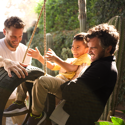


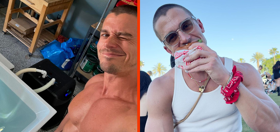





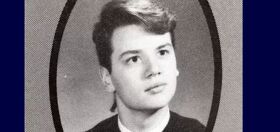



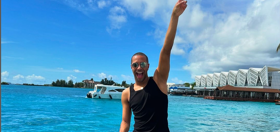
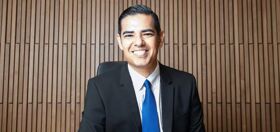

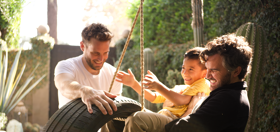



truckproductions
you’re kidding me right? this guy is a steroid abuser clearly.. is this really what you want to perpetuate in the gay community? standards of beauty that are as destructive as the waifish models in fashion for women? ridiculous
Masc Pride
Slanderous accusations like the one above are what the gay community shouldn’t perpetuate. First off, let’s dispel this myth that simply injecting steroids will make you look like Aaron. It doesn’t work like that. Even guys that juice have to go to the gym and put in the work. Secondly, whether he has used steroids or not, the author is certified and has lots of useful information to help guys attain their fitness goals. Try reading and taking his advice. You might find yourself appreciating what you see in the mirror instead of hating on guys that look better than you.
JerseyMike
@Masc Pride: Thank you.. nothing else for me to say..
AaronGuy
@Masc Pride: thank you for the kind words. I’m glad you find my articles helpful and informative. My biggest passion in life is helping people with their health and fitness goals. I’m glad you see the benefit in my credentials, experience and education. That means the world to me.
AaronGuy
@JerseyMike: thank you jersey Mike for the support as well.
Kirby
“Slanderous accusations…”? “…whether he has used steroids or not…”? Wow. It’s clear he has used steroids. That is not even a question. How the imagery matches an article on trying to stay fit after 50 is odd at best; insane at worst. Yeah, the article makes some nice points, but using that model to illustrate these points? Just creepy.
strix1
So much harder as you get older…and my employer does not make easy…I have a standing work station, but in order to keep it, I have to get a form signed by my doctor EVERY 12-months saying I need it, otherwise they will remove it. I eat healthy, but it is soooo expensive. Luckily I have two big dogs that keep active.
AaronGuy
@strix1: I agree. It does get harder but it sounds like you are taking actions to better serve your health and that is commendable. Keep up the good work
AaronGuy
@Kirby: oh Kirby. Always something positive to add to the conversation. I’m sorry my body doesn’t meet your ideal standards to be giving advice to people of a different demographic than myself. The reality of being a great trainer is that we are incredibly capable of training people towards goals other than our own. I hate running but I’ve trained clients to qualify and successfully run Boston’s marathon. It’s no secret that I’m open about my performance enhancing drug use. I come from a bodybuilding background and any competitive bodybuilder that tells you they don’t use steroids, with the exception of natural bodybuilding shows, is lying thru their teeth. I’m also the first to admit that these photos, the professional ones that I use to market and advertise my business, were taken days after a competition while in the best shape of my life, dehydrated, carb depleted, oiled, lit well and shot by an amazing photographer. I’m incredibly upfront about this with all potential clients as well as anyone seeking advice. The expectation to look like this all the time is ludicrous at best and unobtainable for most. That being said, this article talks little about vanity and focuses mostly on feeling better, staying injury free and reducing chronic pain associated with a sedentary lifestyle and the inevitable aging we all endure. Not once did I mention any expectations for anyone to look a certain way and my professional photos should not illicit anyone to feel that way either. Enjoy your day.
AaronGuy
*elicit
Masc Pride
@AaronGuy: No problem, Aaron. Definitely appreciate your contributions here. They’re the only times I know I’ll find something useful on this blog. All the haters and their jeering just means you look good, and they can’t take it! Keep it coming, bro.
midknightryder13
@AaronGuy — I have never read any of your contributions before — but, being a 58 year old man I do appreciate them. I am currently pursuing a doctorate level degree, but I’m in the OC. Nevertheless, I’m in reasonably good shape — but one can always improve. I broke my collarbone, so I’m having to take it slow. But, slow is not the same as non-existent.
And I agree with Masc Pride — keep it coming.
AaronGuy
@midknightryder13: thank you and sorry to hear about your collarbone. Keep up the great work!
Realitycheck
@Masc Pride: Right and Bravo, steroids only increase energy and recovery time, with out work out there is no muscle building, nothing for nothing in this life.
If any one sees a huge guy, to get that big with or with out steroid that guy had to put a lots of daily sweat in it and diet and no party of any kind!
darren michaels
@truckproductions: Your suggestion of “steroid abuser” must be the “oh too often gay man envy”, it’s not out of actual knowledge.
I’ve grown so tired of so many gay men who immediately feel it their place to bad mouth others that have an aesthetic or lifestyle they themselves have not been able to participate in. An opinion should only be offered out of actual knowledge.
The tell tale signs of steroid abuse is considerable size throughout the upper body. The traps, biceps, and chest will gain size AND roundness which the model you have labelled an abuser does not have. He has a good sized chest but no roundness in his traps or biceps and the fact his traps curve down rather than up suggest he is in fact a natural athlete. Too accomplish the shape he has he might very likely have been training since age 15, we don’t know so its entirely unfair. We also don’t know how tall he is, men over 6′ have muscles twice the size of shorter guys which means it takes twice as long to build but when accomplished is very impressive. Which also explains why so many shorter guys have a far easier time getting bigger faster. I’m so tired of gay men being the first ones to tear others down, the very men they should be supporting most. How can we expect others to offer equality when not willing to follow the same path.?
kzen64
@AaronGuy: Wish I was in LA to have you as a trainer. I’m slowly coming out of my couch potato ways. Been walking 5+ miles every couple of days. Ran home the last quarter mile the other day and was a little winded, but not hurting. So, I’ll cutting up the routine with 1/2 running from now on. Need to start adding body weight exercises with the TRX system I bought, plus hit the vertical trainer I bought.
My goal, at 51 is to start trail running and participate in an obstacle course race, like the Spartan or Tough Mudder. I want to loose the gut, and while six pack abs would be nice, just looking more healthy is the goal. Well, that and to get my 20 year old boyfriend not to say I have a Santa belly.
Keep up the good work, and articles. They are appreciated.
David Bolton
This is not “keeping fit.”
This is being a body-builder.
Masc Pride
@darren michaels: Well stated. I think if Aaron was a fem twink that struggled with bench pressing 135, the attitude towards him would be much more welcoming. They interpret his pictures as provocation. A certified trainer being personally attacked for offering fitness advice is totally proof of the jealousy.
@David Bolton: All the Phoenix Effect entries include pictures of the writer and/or the group. If you read the actual text, he’s explaining how core strengthening, joint mobility and stabilization exercises can benefit guys over 50. Nothing written here is about bodybuilding.
Bill Perdue
wowie
David Bolton
Oh come on. The pictures used don’t even come close to portraying the vast majority of men 50 or over—even if they’re in good shape or “fit.” If Queerty is going to run a story about men over 50 who are exercising, then use pics that reflect some of those people rather than an exceedingly small group of men with idealized bodies.
If Queerty would quit being so damn patronizing to its readers, it might actually serve a useful function to some of the gay community.
SFHarry
I appreciate the advice and suggestions put forth in the article but for some reason I feel like something is off here. I just cannot figure it out. The picture doesn’t go with the headline. After reading the comments I realized the picture is not of a man over fifty and felt mislead. I also feel like the picture implies that the goal of someone over fifty should be to look like the guy in the picture. I’m over fifty and my goal is to be toned and in shape to the best of my ability but not to look like a body builder. As I have aged I have come to accept the changes my body is going through and don’t want to look like I’m in my 30s. It just seems inharmonious with growing older gracefully. I can still keep in shape just not in a way that makes me look like I think I’m 30. I find older men who try to look like they are an age they are not end up looking insecure and I find it a turnoff.
I do appreciate the suggestion regarding balance. I’m going to try it next time I go to the gym.